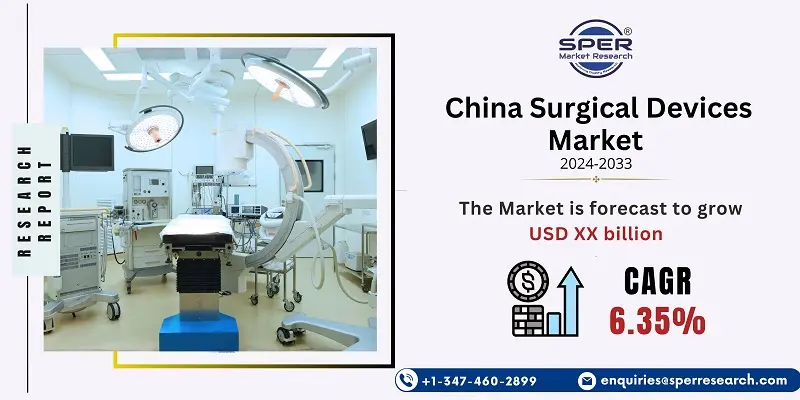
China Surgical Devices Market Growth, Size, Trends, Demand, Share, Revenue and Future Outlook
China Surgical Devices Market Size- By Product, By Application- Regional Outlook, Competitive Strategies and Segment Forecast to 2033
| Published: Jun-2024 | Report ID: MEDE2430 | Pages: 1 - 102 | Formats*: |
| Category : Medical Devices | |||
- Sophisticated Surgical Devices: Industry leaders have been introducing technologically sophisticated surgical devices with improved ergonomics and patient outcomes.
- Strategic Collaborations: Companies have formed relationships with hospitals and healthcare organisations to better understand unique surgical needs and provide customised solutions.


| Report Metric | Details |
| Market size available for years | 2020-2033 |
| Base year considered | 2023 |
| Forecast period | 2024-2033 |
| Segments covered | By Product, By Application |
| Regions covered | Eastern Region, Northern Region, Southern Region, Western Region |
| Companies Covered | B. Braun Melsungen AG, Boston Scientific Corporation, Johnson & Johnson, Conmed Corporation, Integer Holdings Corporation, Olympus Corporation, MEDITECH TECHNOLOGY CO LTD, JINAN XIANFENG MEDICAL DEVICE CO, LTD, Stryker Corporation. |
- Clinicians
- Distributors
- Government healthcare agencies
- Hospitals
- Medical device procurement managers
- Medical professionals
- Researchers
- Surgeons
- Surgical centers
| By Product: |
|
| By Application: |
|
| By Region: |
|
- China Surgical Devices Market Size (FY’2024-FY’2033)
- Overview of China Surgical Devices Market
- Segmentation of China Surgical Devices Market By Product (Handheld Devices, Laproscopic Devices, Electro Surgical Devices, Wound Closure Devices, Trocars and Access Devices, Other Products)
- Segmentation of China Surgical Devices Market By Application (Gynecology and Urology, Cardiology, Orthopaedic, Neurology, Other Applications)
- Statistical Snap of China Surgical Devices Market
- Expansion Analysis of China Surgical Devices Market
- Problems and Obstacles in China Surgical Devices Market
- Competitive Landscape in the China Surgical Devices Market
- Impact of COVID-19 and Demonetization on China Surgical Devices Market
- Details on Current Investment in China Surgical Devices Market
- Competitive Analysis of China Surgical Devices Market
- Prominent Players in the China Surgical Devices Market
- SWOT Analysis of China Surgical Devices Market
- China Surgical Devices Market Future Outlook and Projections (FY’2024-FY’2033)
- Recommendations from Analyst
1.1. Scope of the report1.2. Market segment analysis
2.1. Research data source2.1.1. Secondary Data2.1.2. Primary Data2.1.3. SPER’s internal database2.1.4. Premium insight from KOL’s2.2. Market size estimation2.2.1. Top-down and Bottom-up approach2.3. Data triangulation
4.1. Driver, Restraint, Opportunity and Challenges analysis4.1.1. Drivers4.1.2. Restraints4.1.3. Opportunities4.1.4. Challenges4.2. COVID-19 Impacts of the China Surgical Devices Market
5.1. SWOT Analysis5.1.1. Strengths5.1.2. Weaknesses5.1.3. Opportunities5.1.4. Threats5.2. PESTEL Analysis5.2.1. Political Landscape5.2.2. Economic Landscape5.2.3. Social Landscape5.2.4. Technological Landscape5.2.5. Environmental Landscape5.2.6. Legal Landscape5.3. PORTER’s Five Forces5.3.1. Bargaining power of suppliers5.3.2. Bargaining power of buyers5.3.3. Threat of Substitute5.3.4. Threat of new entrant5.3.5. Competitive rivalry5.4. Heat Map Analysis
6.1. China Surgical Devices Market Manufacturing Base Distribution, Sales Area, Product Type6.2. Mergers & Acquisitions, Partnerships, Product Launch, and Collaboration in China Surgical Devices Market
7.1. China Surgical Devices Market Size, Share and Forecast, By Product, 2020-20267.2. China Surgical Devices Market Size, Share and Forecast, By Product, 2027-20337.3. Handheld Devices7.4. Laproscopic Devices7.5. Electro Surgical Devices7.6. Wound Closure Devices7.7. Trocars and Access Devices7.8. Other Products
8.1. China Surgical Devices Market Size, Share and Forecast, By Application, 2020-20268.2. China Surgical Devices Market Size, Share and Forecast, By Application, 2027-20338.3. Gynecology and Urology8.4. Cardiology8.5. Orthopaedic8.6. Neurology8.7. Other Applications
9.1. China Surgical Devices Market Size and Market Share
10.1. China Surgical Devices Market Size and Market Share By Region (2020-2026)10.2. China Surgical Devices Market Size and Market Share By Region (2027-2033)10.3. Eastern Region10.4. Northern Region10.5. Southern Region10.6. Western Region
11.1. B. Braun Melsungen AG11.1.1. Company details11.1.2. Financial outlook11.1.3. Product summary11.1.4. Recent developments11.2. Boston Scientific Corporation11.2.1. Company details11.2.2. Financial outlook11.2.3. Product summary11.2.4. Recent developments11.3. Johnson & Johnson11.3.1. Company details11.3.2. Financial outlook11.3.3. Product summary11.3.4. Recent developments11.4. Conmed Corporation11.4.1. Company details11.4.2. Financial outlook11.4.3. Product summary11.4.4. Recent developments11.5. Integer Holdings Corporation11.5.1. Company details11.5.2. Financial outlook11.5.3. Product summary11.5.4. Recent developments11.6. Olympus Corporation11.6.1. Company details11.6.2. Financial outlook11.6.3. Product summary11.6.4. Recent developments11.7. MEDITECH TECHNOLOGY CO LTD11.7.1. Company details11.7.2. Financial outlook11.7.3. Product summary11.7.4. Recent developments11.8. JINAN XIANFENG MEDICAL DEVICE CO LTD11.8.1. Company details11.8.2. Financial outlook11.8.3. Product summary11.8.4. Recent developments11.9. Stryker Corporation11.9.1. Company details11.9.2. Financial outlook11.9.3. Product summary11.9.4. Recent developments11.10. Others
SPER Market Research’s methodology uses great emphasis on primary research to ensure that the market intelligence insights are up to date, reliable and accurate. Primary interviews are done with players involved in each phase of a supply chain to analyze the market forecasting. The secondary research method is used to help you fully understand how the future markets and the spending patterns look likes.
The report is based on in-depth qualitative and quantitative analysis of the Product Market. The quantitative analysis involves the application of various projection and sampling techniques. The qualitative analysis involves primary interviews, surveys, and vendor briefings. The data gathered as a result of these processes are validated through experts opinion. Our research methodology entails an ideal mixture of primary and secondary initiatives.



Frequently Asked Questions About This Report
PLACE AN ORDER
Year End Discount
Sample Report
Pre-Purchase Inquiry
NEED CUSTOMIZATION?
Request CustomizationCALL OR EMAIL US
100% Secure Payment






Related Reports
Our Global Clients
Our data-driven insights have influenced the strategy of 200+ reputed companies across the globe.




















